正在加载图片...

A substantial literature,dating back to the mid-1980s,documents that the market reacts negatively,on average,to the announcement of equity issues in the U.S..Convertible bond issues generally are greeted with a moderate negative reaction.Bond offerings have slightly negative reactions,and share repurchases are greeted with positive announcement effects.In the last decade,researchers have examined the long-run performance of firms following these events.The long-run performance evidence shows that in general the market underreacts to the announcement. Most of the literature on long-run performance has focused on relative performance,i.e., do issuing companies underperform a benchmark?Baker and Wurgler(2000),however,present empirical evidence that issuing firms display market timing ability.Using U.S.data on issues of debt and equity (IPOs and SEOs),they find that the fraction of external financing that is equity predicts the following calendar year's stock market return with greater reliability than either the market dividend yield or the market's market-to-book ratio.Baker and Wurgler's sample covers returns from 1928 to 1997.Interestingly,the fraction of equity issuance was highest in 1929,a year that included the October stock market crash.When the sample period is split in two, however,their results hold in both subperiods. If firms can successfully time their equity offerings to take advantage ofwindows of opportunity,"they have a time-varying cost of external capital.How should this affect a firm's investment and financing policies?Stein(1996)addresses this important issue,and concludes that the normative answer depends upon the interaction of two assumptions.The first assumption is whether differences in the cost of external equity reflect misvaluations or differences in equilibrium expected returns.The second assumption is whether managers are trying to maximize short-run firm value or long-run firm value.If one assumes that a low expected return occurs because a stock is overvalued,then managers should issue stock but not invest in low return activities if they are focused on maximizing the wealth of long-term shareholders.On the other hand,if one assumes that low expected returns are rationally being forecast by investors,then a firm should issue stock and use a lower hurdle rate in choosing its investments,much as the neoclassical model of optimal investing and financing would recommend The remainder of this chapter discusses securities issuance.In Section 3,the short-run and long-run reactions to various corporate announcements will be summarized.In Section 4, initial public offerings will be analyzed in detail,with substantial focus on contractual mechanisms.But first,detailed attention is given to firms conducting seasoned equity offerings 2.Seasoned Equity Offerings(SEOs) When a firm that is already publicly traded sells additional stock,the new shares are perfect substitutes for the existing shares.For these transactions,the academic literature tends to use the term seasoned equity offering(SEO),as contrasted with an unseasoned equity offering, an IPO.Practitioners generally use the term follow-on offering,especially if the equity issue is within several years of the IPO.SEOs are also referred to as secondaries,although secondary offering is a term that can mean either a follow-on offering or shares being sold by existing 77 A substantial literature, dating back to the mid-1980s, documents that the market reacts negatively, on average, to the announcement of equity issues in the U.S.. Convertible bond issues generally are greeted with a moderate negative reaction. Bond offerings have slightly negative reactions, and share repurchases are greeted with positive announcement effects. In the last decade, researchers have examined the long-run performance of firms following these events. The long-run performance evidence shows that in general the market underreacts to the announcement. Most of the literature on long-run performance has focused on relative performance, i.e., do issuing companies underperform a benchmark? Baker and Wurgler (2000), however, present empirical evidence that issuing firms display market timing ability. Using U.S. data on issues of debt and equity (IPOs and SEOs), they find that the fraction of external financing that is equity predicts the following calendar year’s stock market return with greater reliability than either the market dividend yield or the market’s market-to-book ratio. Baker and Wurgler’s sample covers returns from 1928 to 1997. Interestingly, the fraction of equity issuance was highest in 1929, a year that included the October stock market crash. When the sample period is split in two, however, their results hold in both subperiods. If firms can successfully time their equity offerings to take advantage of “windows of opportunity,” they have a time-varying cost of external capital. How should this affect a firm’s investment and financing policies? Stein (1996) addresses this important issue, and concludes that the normative answer depends upon the interaction of two assumptions. The first assumption is whether differences in the cost of external equity reflect misvaluations or differences in equilibrium expected returns. The second assumption is whether managers are trying to maximize short-run firm value or long-run firm value. If one assumes that a low expected return occurs because a stock is overvalued, then managers should issue stock but not invest in low return activities if they are focused on maximizing the wealth of long-term shareholders. On the other hand, if one assumes that low expected returns are rationally being forecast by investors, then a firm should issue stock and use a lower hurdle rate in choosing its investments, much as the neoclassical model of optimal investing and financing would recommend. The remainder of this chapter discusses securities issuance. In Section 3, the short-run and long-run reactions to various corporate announcements will be summarized. In Section 4, initial public offerings will be analyzed in detail, with substantial focus on contractual mechanisms. But first, detailed attention is given to firms conducting seasoned equity offerings. 2. Seasoned Equity Offerings (SEOs) When a firm that is already publicly traded sells additional stock, the new shares are perfect substitutes for the existing shares. For these transactions, the academic literature tends to use the term seasoned equity offering (SEO), as contrasted with an unseasoned equity offering, an IPO. Practitioners generally use the term follow-on offering, especially if the equity issue is within several years of the IPO. SEOs are also referred to as secondaries, although secondary offering is a term that can mean either a follow-on offering or shares being sold by existing